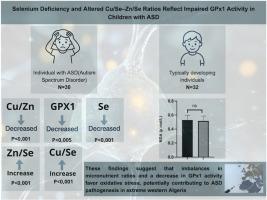硒缺乏和改变与GPx1活性相关的Cu/Se、Zn/Se和Cu/Zn比率:自闭症谱系障碍中氧化应激的非侵入性生物标志物
IF 8.2
2区 生物学
Q1 BIOCHEMISTRY & MOLECULAR BIOLOGY
引用次数: 0
摘要
金属微量元素失衡似乎与自闭症谱系障碍(ASD)的风险有关。硒(Se)、铜(Cu)和锌(Zn)是防御氧化应激(OS)所必需的,是维持突触发生和神经发生的关键因素。本研究评估了阿尔及利亚ASD儿童血浆中硒、铜和锌的浓度及其比值、丙二醛(MDA)水平和红细胞谷胱甘肽过氧化物酶(GPx1)活性。共有30名被诊断为ASD的受试者和32名神经典型发育(ND)儿童参加了本研究。用极谱分析仪测定微量元素水平。血浆丙二醛采用紫外分光光度法测定,红细胞GPx1活性采用SPECORD®210加双光束分光光度计(Analytik Jena German)测定。ASD患儿的Cu/Zn比值显著低于ASD患儿(p本文章由计算机程序翻译,如有差异,请以英文原文为准。

Selenium deficiency and altered Cu/Se, Zn/Se and Cu/Zn ratios associated with GPx1 activity: non-invasive biomarkers of oxidative stress in autism spectrum disorders
Metal micronutrient dyshomeostasis appears to be involved in the risk of autism spectrum disorders (ASD). Selenium (Se), copper (Cu) and zinc (Zn) are essential for the defence against oxidative stress (OS), a key factor in the maintenance of synaptogenesis and neurogenesis. This study assessed plasma concentrations of Se, Cu, and Zn, along with their ratios, malondialdehyde (MDA) levels, and erythrocyte glutathione peroxidase (GPx1) activity in Algerian children with ASD.
A total of 30 subjects diagnosed with ASD and 32 neurotypically developing (ND) children participated in this study. Trace element levels were measured using a polarographic analyzer. Plasma MDA was determined by UV spectrophotometry and erythrocyte GPx1 activity using a SPECORD® 210 plus dual beam spectrophotometer (Analytik Jena German).
The Cu/Zn ratio was significantly lower in children with ASD (p < 0.001), while no significant difference was found for MDA between the two study groups. However, in children with ASD, a positive correlation was found between MDA and the plasma Cu/Zn ratio (r = 0.6874, p = 0.005).
Se levels and GPx1 erythrocyte activity were significantly lower in children with ASD compared with the ND children (p < 0.001; p < 0.05). Cu/Se and Zn/Se ratios were significantly higher in children with ASD (p < 0.001).
Sex-stratified analysis indicated a specific vulnerability to OS among boys with ASD, while no significant age-related differences were observed in children with ASD.
These findings suggest that imbalances in micronutrient ratios and a decrease in GPx1 activity favor OS, potentially contributing to ASD pathogenesis in extreme western Algeria.
求助全文
通过发布文献求助,成功后即可免费获取论文全文。
去求助
来源期刊

Free Radical Biology and Medicine
医学-内分泌学与代谢
CiteScore
14.00
自引率
4.10%
发文量
850
审稿时长
22 days
期刊介绍:
Free Radical Biology and Medicine is a leading journal in the field of redox biology, which is the study of the role of reactive oxygen species (ROS) and other oxidizing agents in biological systems. The journal serves as a premier forum for publishing innovative and groundbreaking research that explores the redox biology of health and disease, covering a wide range of topics and disciplines. Free Radical Biology and Medicine also commissions Special Issues that highlight recent advances in both basic and clinical research, with a particular emphasis on the mechanisms underlying altered metabolism and redox signaling. These Special Issues aim to provide a focused platform for the latest research in the field, fostering collaboration and knowledge exchange among researchers and clinicians.
 求助内容:
求助内容: 应助结果提醒方式:
应助结果提醒方式:


